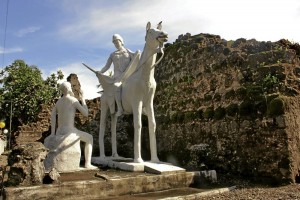
THE RUINS of the 15th century Taal church is one of the known landmarks in San Nicolas, Batangas. The site is where the original Taal church stood before it was leveled during the 1754 Taal volcano eruption. In recent years, the local government built statues of San Nicolas de Tolentino, who became the town’s patron saint. MARICAR P. CINCO
SAN NICOLAS, Batangas—San Nicolas, a poor municipality along Taal Lake in Batangas, is hooking up with Tagaytay City in Cavite, a popular tourist destination overlooking the Taal Volcano, in a bid to boost its own tourism revenues and job opportunities.
Officials of the two local governments have signed a memorandum of agreement to formalize their sisterhood. The event was also viewed as a gesture to end a silent rivalry between them over the coveted Taal Volcano in Batangas.
“In the first place, there’s no conflict so we have nothing to solve here,” said Tagaytay Mayor Abraham Tolentino on the sidelines of the signing held in San Nicolas early this month.
The perceived rift was highlighted last year, when Batangas proposed to put up a Hollywood-style signage on the Taal Volcano as a way of claiming it. Tagaytay, which offers the best view of the volcano aside from its cool breeze and amenities for tourists, shot down the plan.
“It was just a proposal that was exaggerated and magnified and became an issue,” said Batangas Gov. Vilma Santos-Recto when asked about the shelved signage project.
“At the end of the day, nobody owns Taal Volcano. What’s important is that we all take care of it,” she added.
Recto expressed elation over the partnership, saying it would not only bolster tourism efforts but also provide jobs to Batangas residents.
The partnership will involve an exchange of tourism and development plans, technology and marketing strategies.
For instance, Tolentino said promotional posters of San Nicolas could be placed at hotels and restaurants in Tagaytay.
“We are choosy of the towns we partner with, but we were pleasantly shocked after realizing the potentials (of this town). We could connect Tagaytay to Batangas through San Nicolas,” he said.
San Nicolas, a fifth-class municipality (annual income: P15 million-P25 million) is less than an hour’s drive from Tagaytay, Cavite’s premier but second-class city (annual income: P320 million-P400 million).
“We may be a small town but we believe this could be the start of development in San Nicolas,” San Nicolas Mayor Epifanio Sandoval said.
It is “the real gateway” to Taal Volcano since it is closer to the volcano island—three to four kilometers from the mainland—than any other lakeshore municipality, he said.
Talisay town on the other side of the lake has also called itself the “gateway” as part of its promotional campaign.
Addressing members of the Tagaytay city tourism council and a group of hotels and restaurant owners from Tagaytay, Sandoval presented a possible itinerary of tourists in San Nicolas: a river cruise on the 9-km Pansipit River and a half-hour boat ride to the volcano island, where tourists can trek or ride horses to the 1965 and 1911 craters, and a bird sanctuary.
The municipal government also plans to open a “floating restaurant,” a barge offering lunch for tourists.
San Nicolas, at the very least, needs to improve the roads, security and facilities, such as comfort rooms, before it starts hosting tourists, Tolentino noted.
He also suggested to develop into a historical site the ruins of a 15th-century old church leveled after the 1754 Taal Volcano eruption.
Although San Nicolas is seen to benefit more from the partnership, Tolentino said he was looking at it as an “add-on” to what Tagaytay is already offering its tourists. “We can lengthen the itinerary of the tourists. During daytime, they could go to San Nicolas and return to Tagaytay City where they are lodged,” he said.